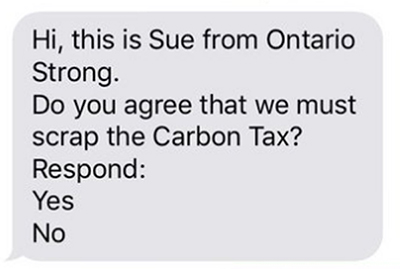How Sue from Ontario Strong & Andrew Scheer Screwed Up with Mass Texting / SMS
Table of Contents


Both of these messages caused some backlash for entirely predictable reasons.
For starters, each campaign was poorly executed (in addition to messaging people who didn’t request their messages, Scheer’s text had a credibility-killing typo in it and Ontario Strong’s 3-page web site didn’t reveal anything about the organization or the people behind it or explain how they managed to gain access to the phone numbers of thousands of Ontarians).
Updated July 10: The Vancouver Sun is reporting that iMarketing Solutions Inc., the company that sent the “Sue from Ontario Strong” message, was founded by directors of Responsive Marketing Group, the company behind the 2011 Robocalls scandal. More details here.
Worse, they both revealed a startling lack of understanding of the relationship that people have with their cell phones and with text message communications in general.
It’s unfortunate because it didn’t need to be that way. When used properly, mass or bulk texting is a powerful communications tool.
A Little Background Info…
There’s a Canadian Federal election looming and politicians of all stripes are looking for an edge – a way to reach an audience that’s already bombarded 24/7 with voices clamouring for their attention.
It’s definitely a challenge.
Print, radio and television advertising is expensive.
Social media is noisy and is a difficult medium to command attention on. Online advertising… well, was the last time you clicked on an ad online or watched a complete YouTube “pre-roll” ad to the end?
Yeah, no.
SKIP.
Is Mass Texting is the Answer?
It was inevitable.
Eventually, somebody in Canada was bound to make the connection between people’s crazy relationships with their cell phones and texting… that simple, cheap and unintimidating technology that’s used by everyone and their grandmother.
In the U.S., texting has been used in politics for some time—Barack Obama’s was the first presidential campaign to utilize the power of SMS/text messaging in 2008.
After all, the numbers measuring text message engagement are pretty astounding.
Depending on which ones you look at, statistics show that between 95-99% of text messages are opened and read, the majority within a few minutes.
Why such high engagement? There are 4 main reasons…
- Proximity to phone: Statistics show the average person has their phone within arm’s reach 14 hours out of every day.
- Engagement: Studies show the average person checks their phone 150 times per day, regardless of it ringing or signalling.
- Unintrusive: Unlike a phone call that interrupts your day and requires you to stop what you are doing, text messages are unintrusive and take seconds to read.
- Message source: Texting is a personal communication channel. For the most part, text messages originate from someone within your social circle – someone with whom you have a personal relationship. That, in a nutshell, is why we’re so interested in opening and reading them.
The first three listed here are obviously important, but it’s the fourth one that is the “doozy” so let me expand on it a bit…
The laws regarding the sending of commercial bulk text/SMS messages in both Canada and the U.S. are rather strict, and for the most part, the mobile carriers have done a decent job of preserving the value of texting by filtering out most unsolicited commercial messages or cutting them off at the source. That means when your phone signals the arrival of a new text message, 99.9 times out of 100, it’s one of the following…
- Personal correspondence from family members or loved ones, co-workers or colleagues.
- A commercial message from a business or company that has your permission to contact you (i.e. they have either express or implied consent as defined by Canada’s Anti Spam Legislation).
- A non-commercial message from a business you have a relationship with (i.e., an appointment reminder message from your dentist or chiropractor).
When a message arrives that doesn’t fall into one of these 3 categories, the “you-know-what” can hit the fan.
People are livid. Seriously.
Sending a text message out of the blue and asking something from the recipient without any sort of introduction is the technological equivalent of walking into a stranger’s house without knocking, marching into the dining room, pulling up a chair at the dinner table and helping yourself to a plate of roast beef without even acknowledging the hosts.
If that sounds a little extreme, I get it. But underestimating just how pissed off Canadians get when they receive an unsolicited text is a serious, serious mistake.
The biggest problem lies with the assumption that cell phones are just portable landlines.
Nothing could be further than the truth. Cell phones are the control centre of many people’s entire lives and as a result, intruding here without an invitation makes people feel like you’ve violated their personal space. In other words, it feels personal in a way that email spam never does.
How to do Mass Texting Properly: A Primer for Politicians
Texting is a powerful tool and it can benefit anyone who uses it properly. But used improperly, it can do nothing but increase the distrust and disillusionment Canadians currently have for politicians.
So here are 3-ways how to do mass texting “right”…
1. Make Your Program Opt-In Only.
In other words, only send messages to the people who have subscribed to receive them. This does three things…
- Dramatically reduces the cost of your SMS campaigns.
- Only delivers your messaging to those interested in hearing it.
- Does not annoy or alienate people (who may still be responsive to hearing your message through some other medium).
This is the smartest and most respectful way to use mass texting and the strategy I personally recommend you use.
Adage has a great article here on the strategies used by Barack Obama to build his massive permission-based list of SMS contacts.
2. Use the Andrew Scheer / Ontario Strong Model… but Better.
There are pros and cons to messaging people who don’t have a relationship with your party and/or have not specifically requested to receive texts from you.
On the “pros” side, you aren’t limiting yourself to messaging people who are probably going to vote for you anyway—you can get your message in front of people who wouldn’t normally be exposed to it.
On the “cons” side, it’s not clear whether this intrusion of personal privacy will earn you more converts than detractors. There’s also the logistical issue of coming up with a database of phone numbers and responding to your constituents when they ask, “how did you get my number?”
If you can solve these problems and think the “pros” outweigh the “cons”, here are some tips to mitigate the fallout from your campaigns…
- Whenever possible, use personalization. Calling someone by their first name in a text message makes a huge difference as to how they perceive it.
- Give them the option to opt-out. People can block your number or report your number as spam, so there’s nothing to gain by not doing so.
- Get multiple “eyes” on your message so no typos are sent. These are serious credibility killers.
- Message regularly—once a week. Not only does building a relationship require consistent communication, but people are busy—it may take several messages before they’re able to find the time to click through to your web site, read about your policies, complete a short survey, etc.
- In your first text, don’t ask for anything. Introduce yourself and explain why you’re connecting. For example, “Hi Paul, it’s Mike from XYZ Party. I’m hoping to get your input on issues that are important to you. If you’d rather not contribute, please reply STOP to end my messages. Otherwise, visit http://www.linktoprogram.ca to learn more about this program.
Please note that the link in the first text message needs to direct the recipient to a mobile responsive web page that discusses your texting program, not your policies and proposals (that comes second).
In general, Canadians are skeptical of mass texting and unless you answer the most common questions to their satisfaction, a large percentage of them will unsubscribe or block your number to prevent the receipt of further messages. Here are the sort of questions you should address…
- Is there a cost to be on this program? Is there a charge to receive messages from you?
- Is my data private?
- Where did you get my number?
- How often will you message me?
- What sort of content should I expect to receive from you? (eg, links to policy papers/discussions, invitations to local events, requests to complete surveys, etc.).
- What happens if I unsubscribe?
- Will you sell my number to others?
Only after addressing these questions should you segue into a discussion on your beliefs and your platform.
3. Use it Internally
The third option for using mass or bulk texting is to use it internally within your campaign.
Text messaging is a great tool for mobilizing volunteers, alerting staff upcoming events, changes in schedules, and so on.
The Takeaway Lesson
Both Scheer’s and Ontario Strong’s decision to send text messages to people who had not requested them may have been a calculated risk. However, where they both screwed up is underestimating just how intrusive uninvited text messages are perceived to be.
It’s not like sending an uninvited email. We all get hundreds of those.
Texts are hyper-personal. Perhaps the most partisan of individuals will appreciate messaging that speaks to their political leanings, but I strongly suspect the majority of Canadians will not appreciate the intrusion into their personal space.
Here’s the bottom line: people are intimately connected to their phones. Intruding here without an invitation could backfire spectacularly.
My recommendation?
Be respectful of people’s privacy and implement the suggestions in this article to disseminate your messaging in a way that’s a big WIN for everyone.

